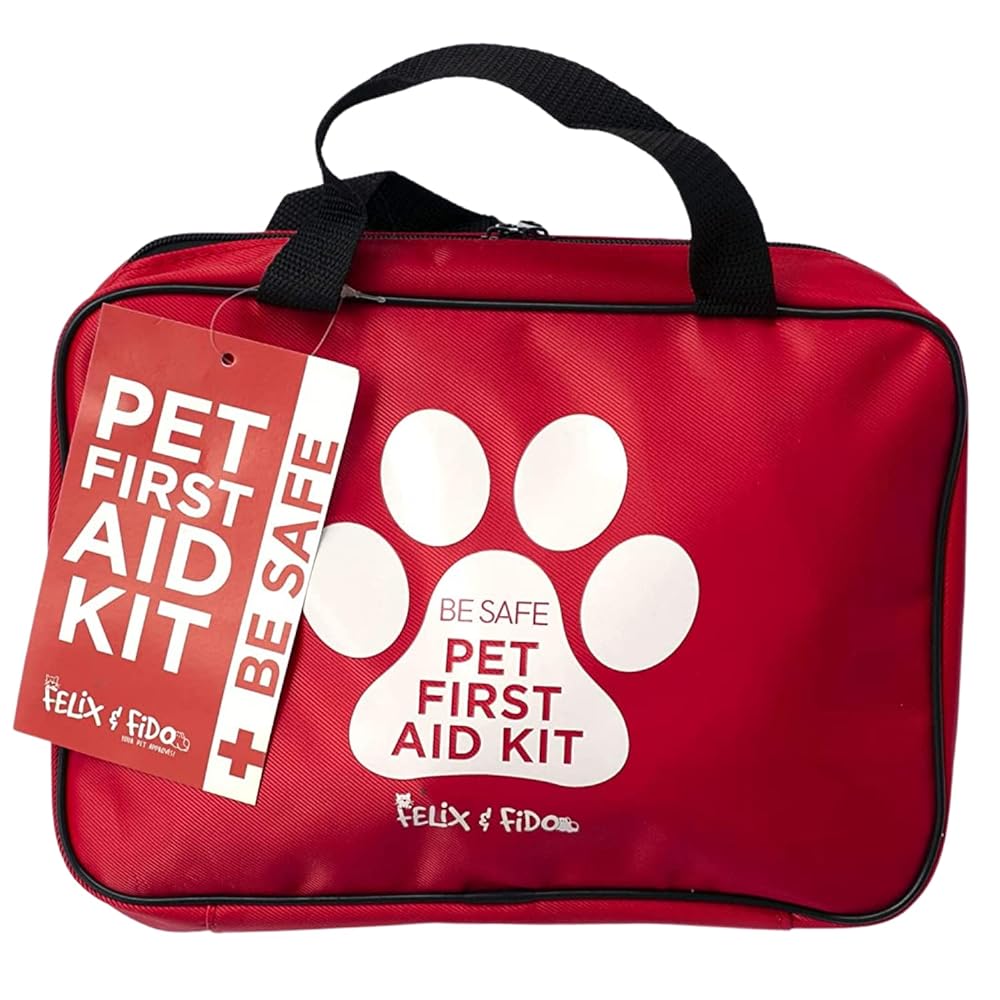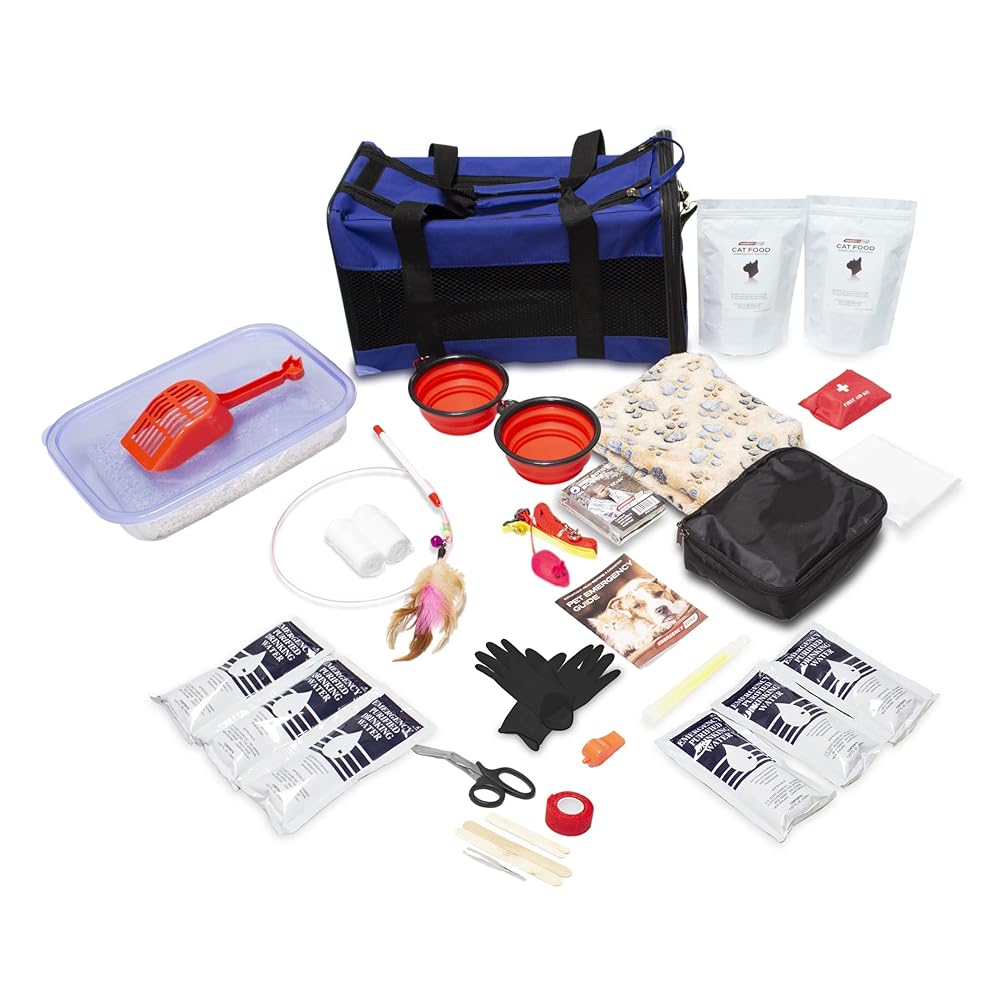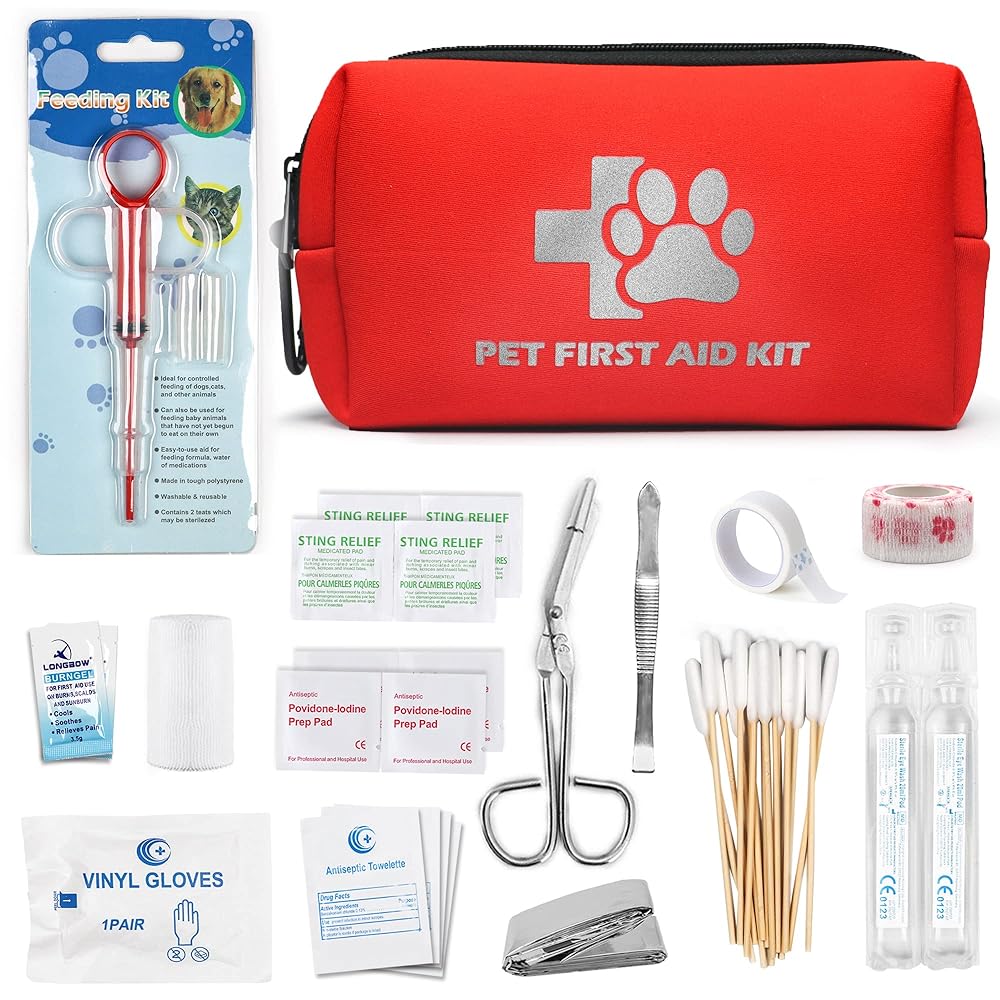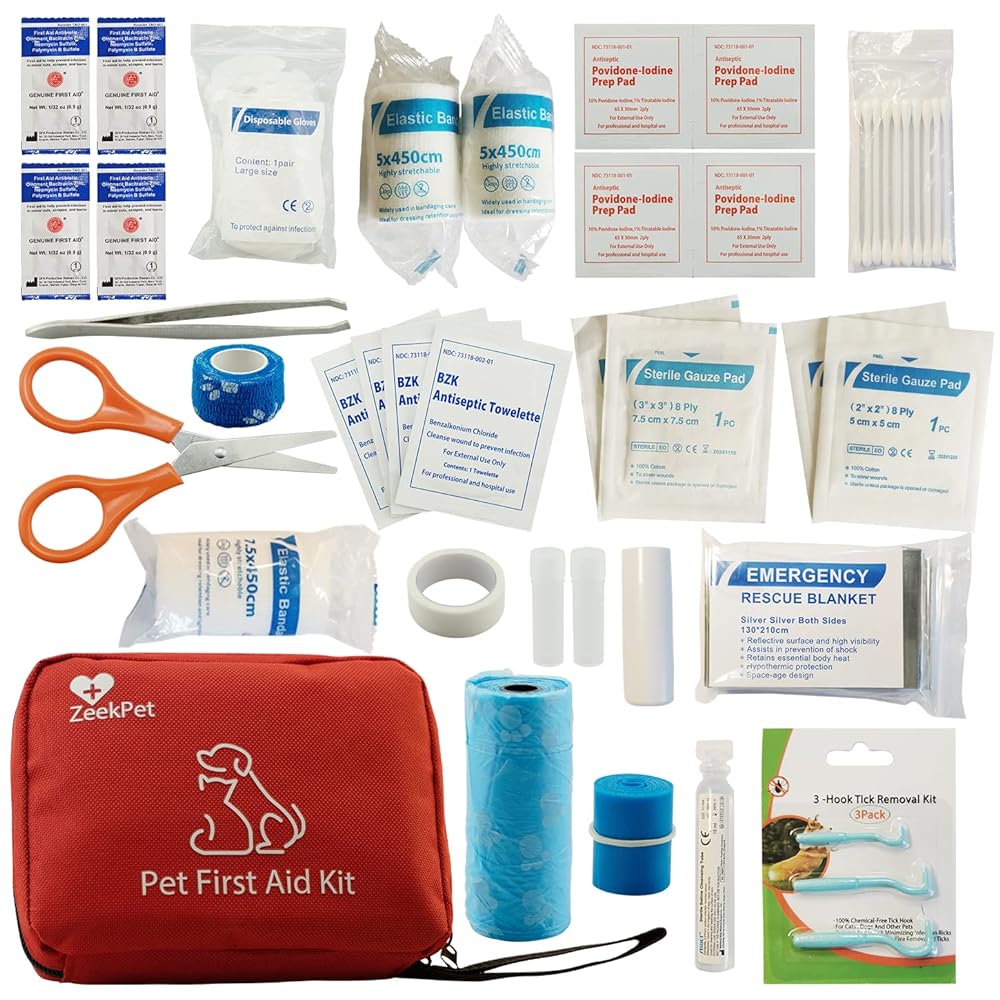Looking for the Best Cat First Aid Kits? Every responsible cat owner knows the importance of being prepared for emergencies. Just like humans, cats can encounter situations that require immediate medical attention. A well-stocked first aid kit tailored to feline needs can be a lifesaver in such circumstances. This article will guide you through the top cat first aid kits available, ensuring you have the essentials to care for your furry friend during unexpected incidents. Let’s dive in to find the perfect fit for your feline’s safety needs!
1. BE SAFE! Pet First Aid Kit- 50 pc First Aid Kit for Your Pets
The Be Safe Pet First Aid Kit is a comprehensive kit containing 50 pieces of essential first aid items for your pets. It comes in a durable bag with three sections and handles for easy carrying. The kit is designed for travel and outdoor activities, making it a must-have for camping, hiking, and wilderness trips. The kit includes items such as antiseptic wipes, gloves, dressing pads, an emergency lead with reflective tape, and a waterproof information card. Customer satisfaction is guaranteed by the manufacturer.

2. Emergency Zone – Cat Emergency Survival Kit – Bug Out, Emergency, Travel Kits
The Emergency Zone Cat Emergency Survival Kit is a comprehensive kit designed to ensure the safety and well-being of your feline friend during emergency situations. It includes essential supplies such as food, water, and a blanket to meet your cat’s basic physical needs. Additionally, the kit comes equipped with toys to help distract and comfort your cat in unfamiliar environments. Overall, the Emergency Zone Cat Emergency Survival Kit offers peace of mind and preparedness in case of emergencies.

3. JUSAID Pet First Aid Kit – 40 Pieces Pet Emergency Kit to Clean and Care for Most Injuries
The JUSAID Pet First Aid Kit is a comprehensive kit that includes 40 pieces of essential supplies for pet emergencies. It includes items like bandages, cleansing wipes, and a space blanket, among others. The kit is compact and portable, making it easy to carry and store in vehicles or when traveling. It is made of durable and water-resistant material, ensuring it can withstand various conditions. Overall, it is a useful and practical kit to have on hand for pet owners in case of emergencies.

4. Pet First Aid Kit ZeekPet Medical Bag for Dogs and Cats Trauma Kit
The Pet First Aid Kit by ZeekPet is a comprehensive medical bag designed for dogs and cats in case of trauma or emergencies. It includes essential items such as self-adhering bandages, styptic pencils, tick removal tools, emergency blankets, and a pill box. The kit is well-organized and lightweight, making it convenient for travel and outdoor activities. It also comes with a pet first aid guidebook for reference.
5. GPUSFAK Pet First Aid Kit for Dogs & Cats
The GPUSFAK Pet First Aid Kit for Dogs & Cats is a comprehensive kit that includes both first aid supplies and grooming tools. It contains items such as gloves, bandages, tweezers, and scissors for emergency care, as well as a digital thermometer, tick remover, and pet pill feeder for daily care. The kit is designed to be portable and easy to carry, making it suitable for activities such as hiking and camping. It is suitable for various pet breeds and can also be a thoughtful gift for pet owners.

What Items Should Be in a Cat First Aid Kit?
- Gauze pads and rolls: For dressing wounds or muzzling an injured cat.
- Adhesive tape: To secure bandages or gauze.
- Antiseptic wipes or solution: To clean wounds or cuts.
- Cotton balls or swabs: For cleaning and applying medications.
- Tweezers: To remove splinters or ticks.
- Scissors: For cutting tape, gauze, or fur.
- Digital thermometer: Cats’ temperature should be taken rectally.
- Disposable gloves: To keep both you and the injury clean.
- Eye dropper or syringe: To give oral medications or flush wounds.
- Sterile saline solution: Useful for cleaning wounds or flushing out eyes.
- Hydrogen peroxide (3%): Can induce vomiting (but always consult a vet before inducing vomiting).
- Styptic powder or pen: To stop bleeding from minor cuts or a torn nail.
- Antibiotic ointment: For treating minor cuts or abrasions.
- Alcohol pads: For disinfecting tools or thermometers.
- Emergency blanket: To keep an injured or shocked cat warm.
- Rectal lubricant: For thermometer use.
- Towel or cloth: To wrap or comfort the cat or as a makeshift stretcher.
- Emergency contact numbers: Your veterinarian, the nearest emergency clinic, and a poison control hotline.
- Benadryl: For allergic reactions (always consult a vet for the correct dosage).
- A flashlight: Useful for checking your cat’s pupils or looking into their mouth.
Frequently Asked Questions about Cat First Aid Kits
1. What should I include in a basic cat first aid kit?
A basic cat first aid kit should contain essential items such as antiseptic wipes, sterile gauze pads, adhesive tape, scissors with blunt ends, tweezers, a digital thermometer, disposable gloves, and a first aid booklet specifically for cats. Other useful additions can be a tick remover tool, saline solution, and an Elizabethan collar (or “cone”).
2. Why is it important to have a cat-specific first aid kit?
Cats have unique anatomical and physiological differences from other animals. A cat-specific first aid kit ensures that all the tools and medications are appropriate for feline use. For instance, certain medications that are safe for dogs may be toxic to cats.
3. Can I give my cat human medication if it’s injured or in pain?
No, it’s crucial to avoid giving cats human medications unless explicitly instructed by a veterinarian. Many human medications, including over-the-counter pain relievers, can be toxic to cats and can cause serious complications or even death.
4. How often should I check or update my cat’s first aid kit?
At least once a year, you should check the expiry dates on any medications, replace used or outdated items, and ensure that everything is in good condition. This ensures that when an emergency arises, everything in the kit is effective and safe to use.
5. Should I include a list of emergency numbers in the kit?
Absolutely! Including a list of emergency numbers, such as your veterinarian’s office, an emergency vet clinic, and possibly a pet poison hotline, can be invaluable during a crisis when time is of the essence.
6. What should I do if my cat ingests something poisonous?
Firstly, don’t panic. Remove any remaining substance from the cat’s reach and try to identify what was ingested. Call your vet or a pet poison hotline immediately. Do not induce vomiting unless instructed to do so by a professional.
7. Why is it recommended to have an Elizabethan collar in the first aid kit?
An Elizabethan collar, commonly referred to as a “cone,” prevents a cat from licking, biting, or scratching at an injury, wound, or surgical site. Having one on hand can prevent further injury or infection in emergency situations.
8. Can I use hydrogen peroxide to clean my cat’s wounds?
While hydrogen peroxide can kill bacteria, it can also be too harsh for cat wounds, potentially delaying healing. It’s often better to use saline solution or an antiseptic designed for pets. If unsure, always consult with your vet.
9. How can I keep my cat calm while administering first aid?
Try to approach your cat calmly and speak to it in a soothing tone. If possible, wrapping the cat in a towel or blanket (a technique called “kitty burrito”) can help restrict movement and provide a sense of security. You might also consider having a calming spray or wipes made for cats in your kit.
10. How do I know when it’s time to use the first aid kit versus going straight to the vet?
The first aid kit is designed to provide immediate care in emergency situations or minor injuries. However, if the injury or ailment seems severe, such as difficulty breathing, major trauma, uncontrollable bleeding, or suspected poisoning, it’s always best to go straight to the vet after stabilizing the situation as best you can.
Final Summary: The Best Cat First Aid Kits
In this article, we reviewed the Best Cat First Aid Kits. Being equipped for unexpected emergencies is vital for the well-being of your beloved feline companion. A top-notch first aid kit ensures you’re always ready to provide immediate care. By selecting a comprehensive kit, you not only ensure your cat’s safety but also gain peace of mind. Always prioritize your pet’s health, and remember, in serious situations, always consult with a veterinarian. Stay prepared, and ensure your cat’s safety with the best tools at your disposal.





